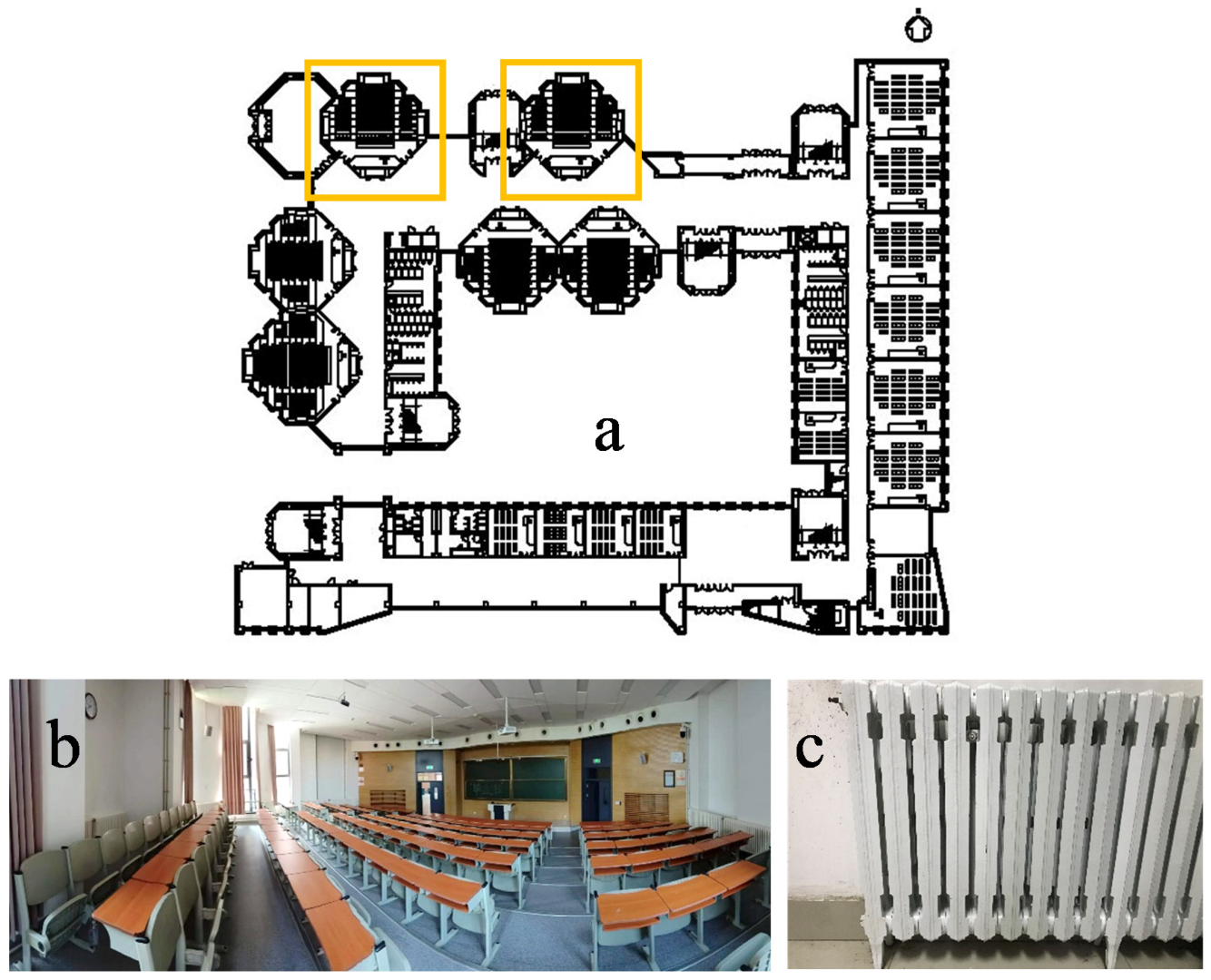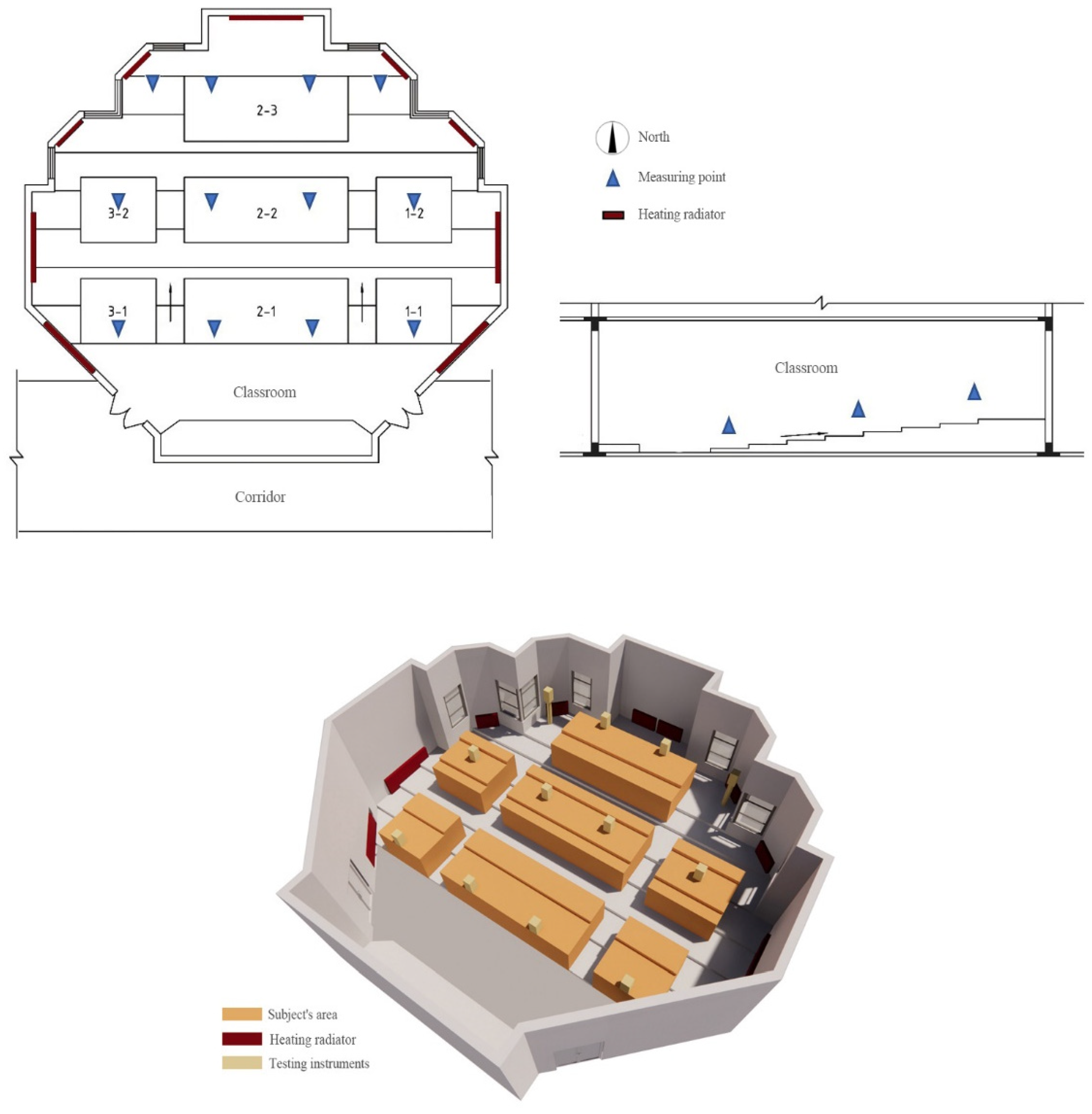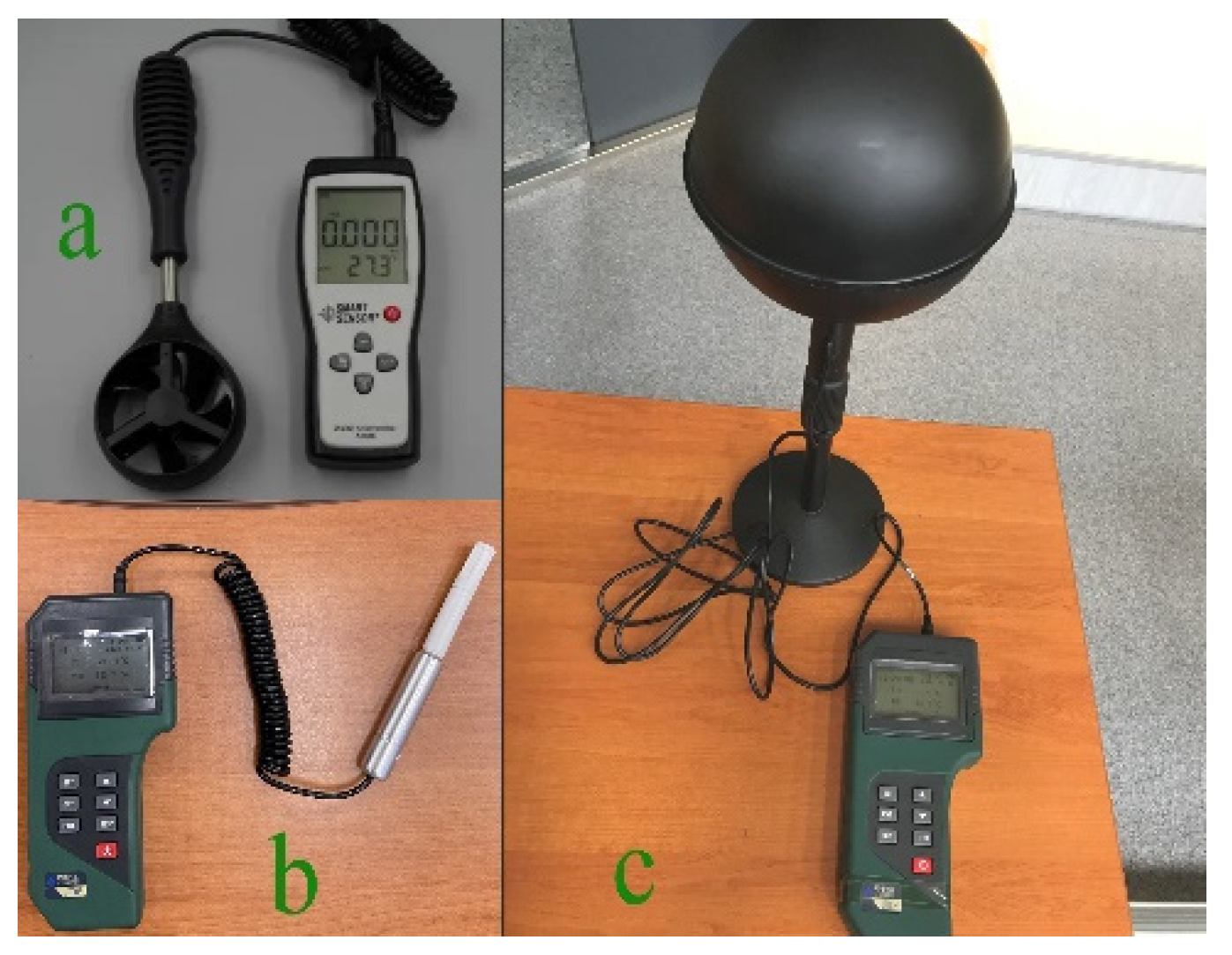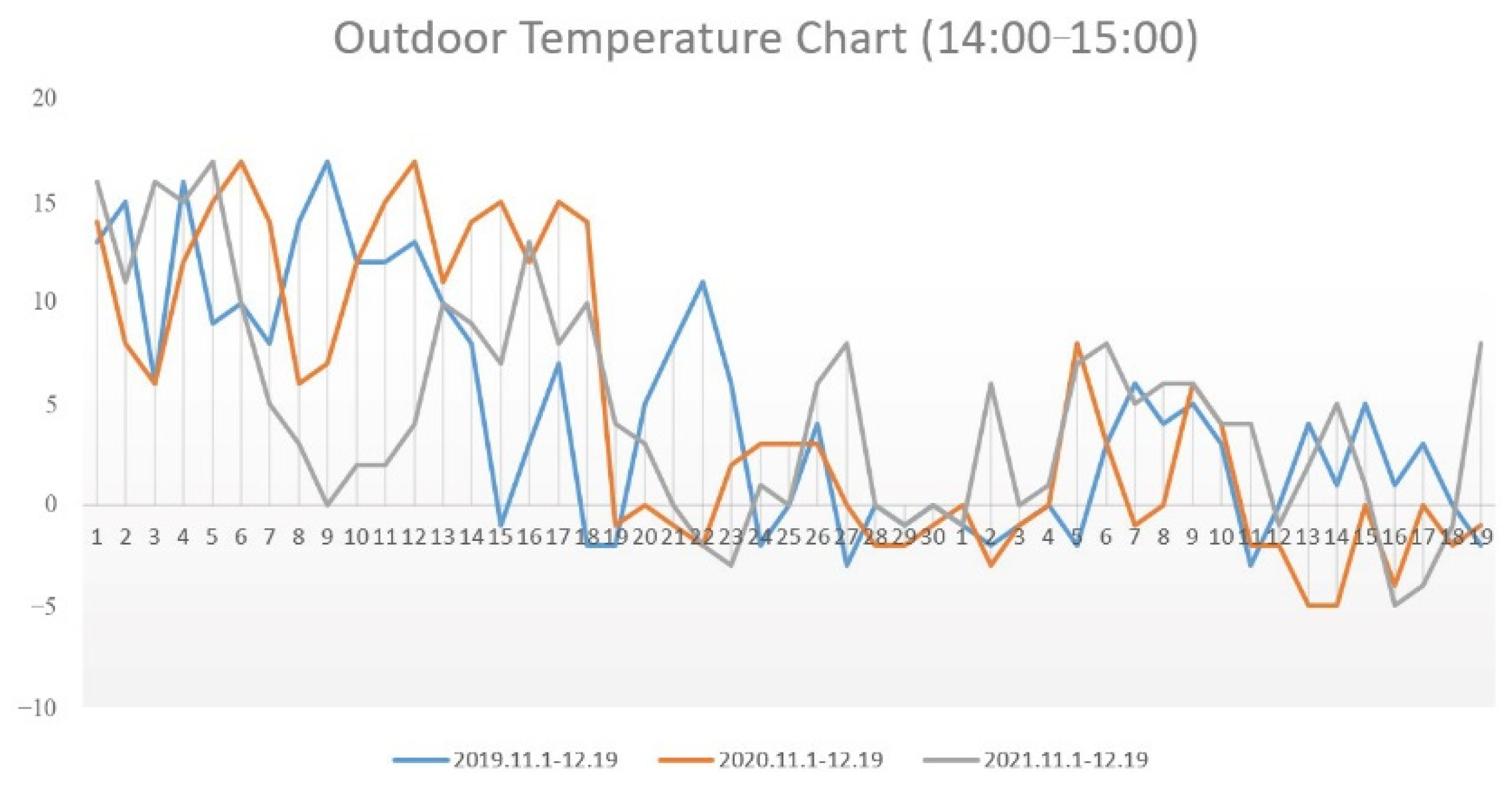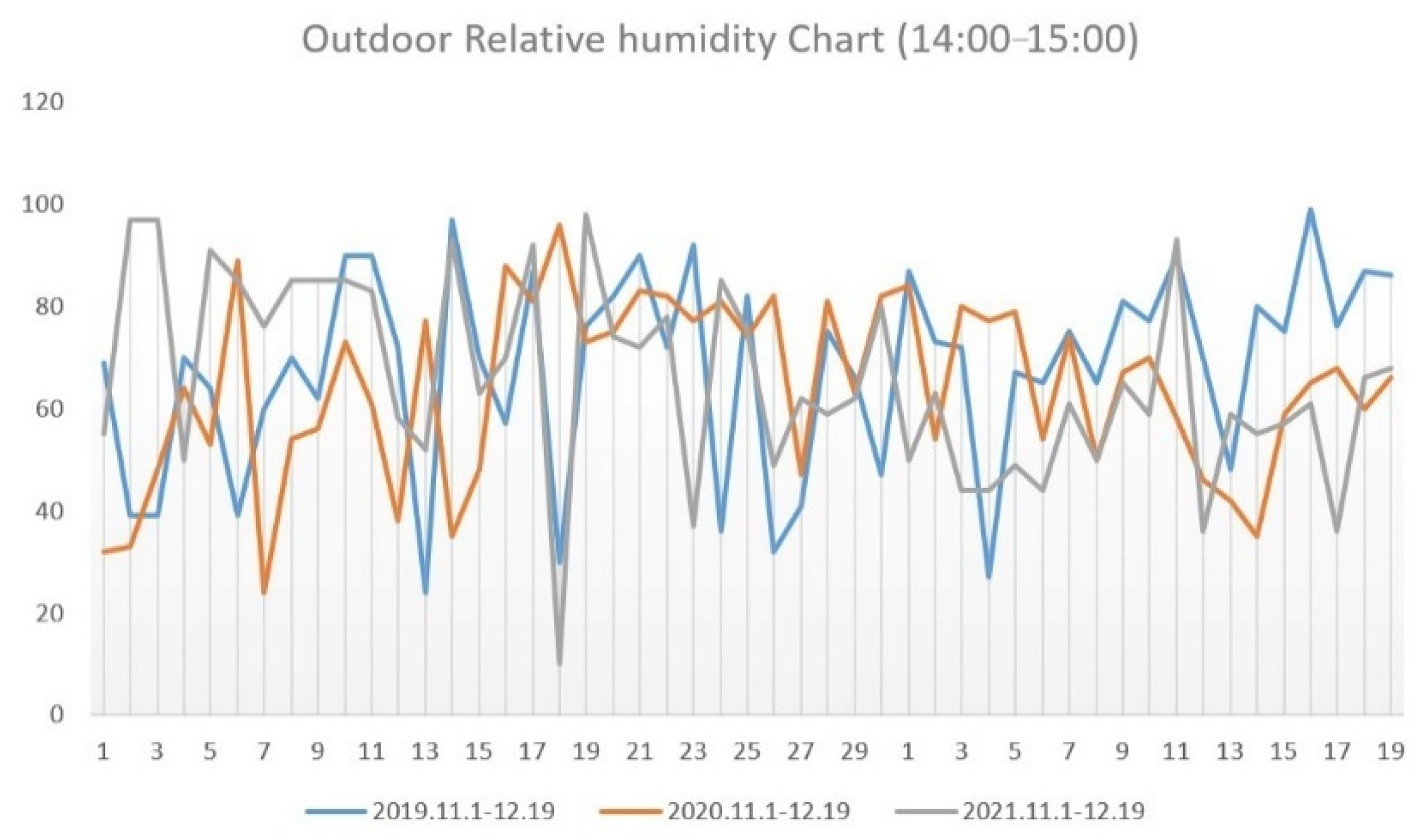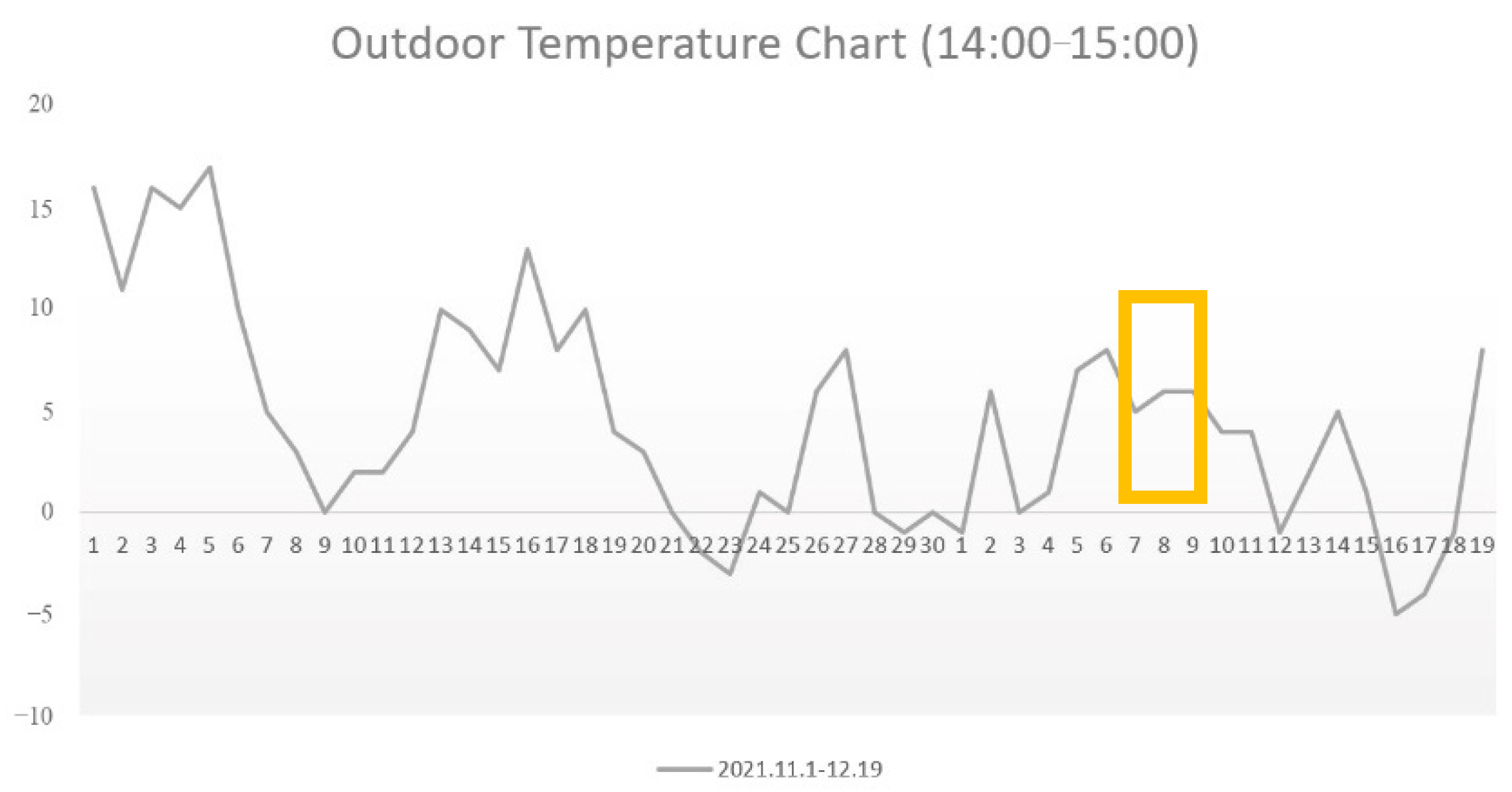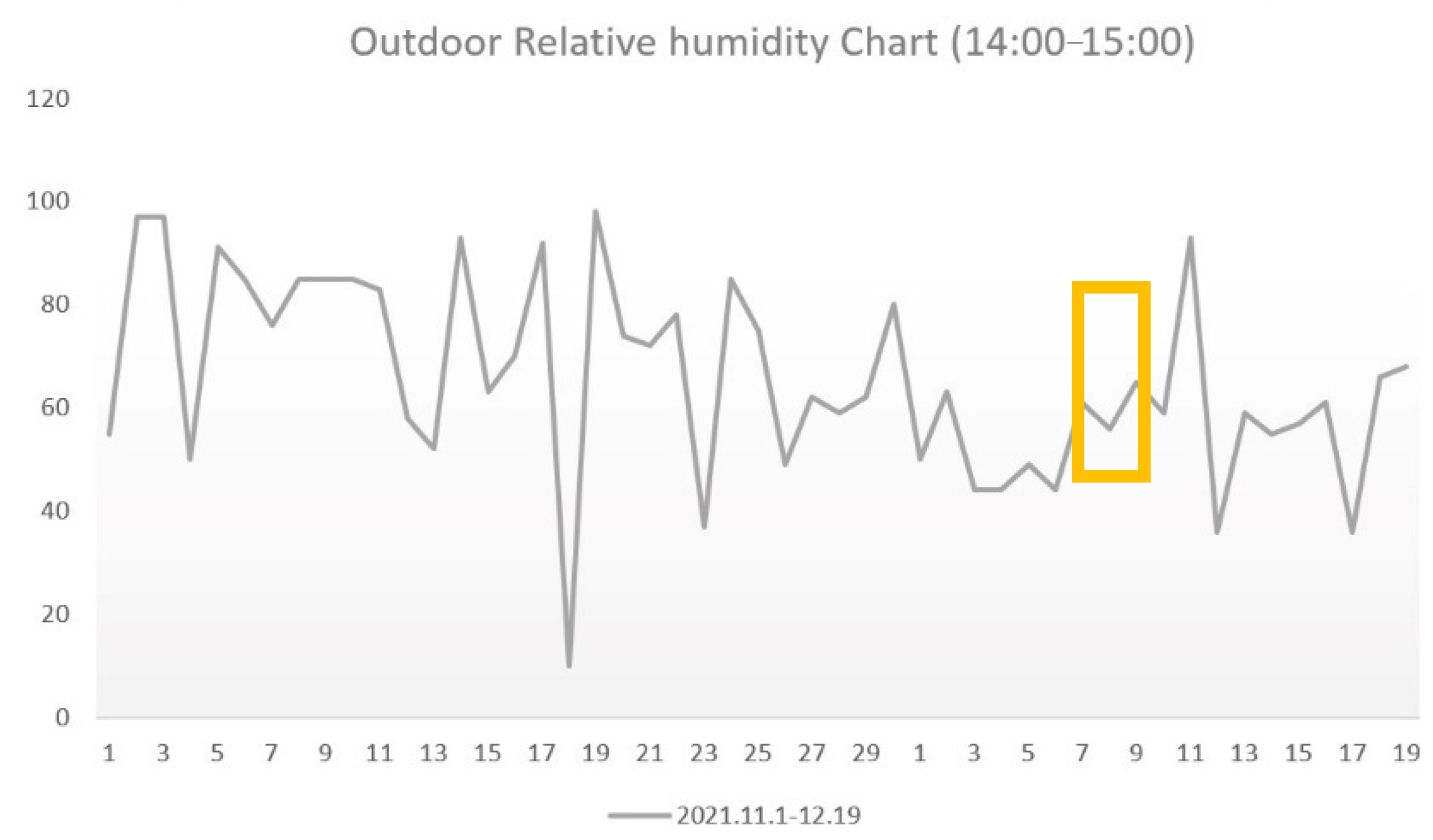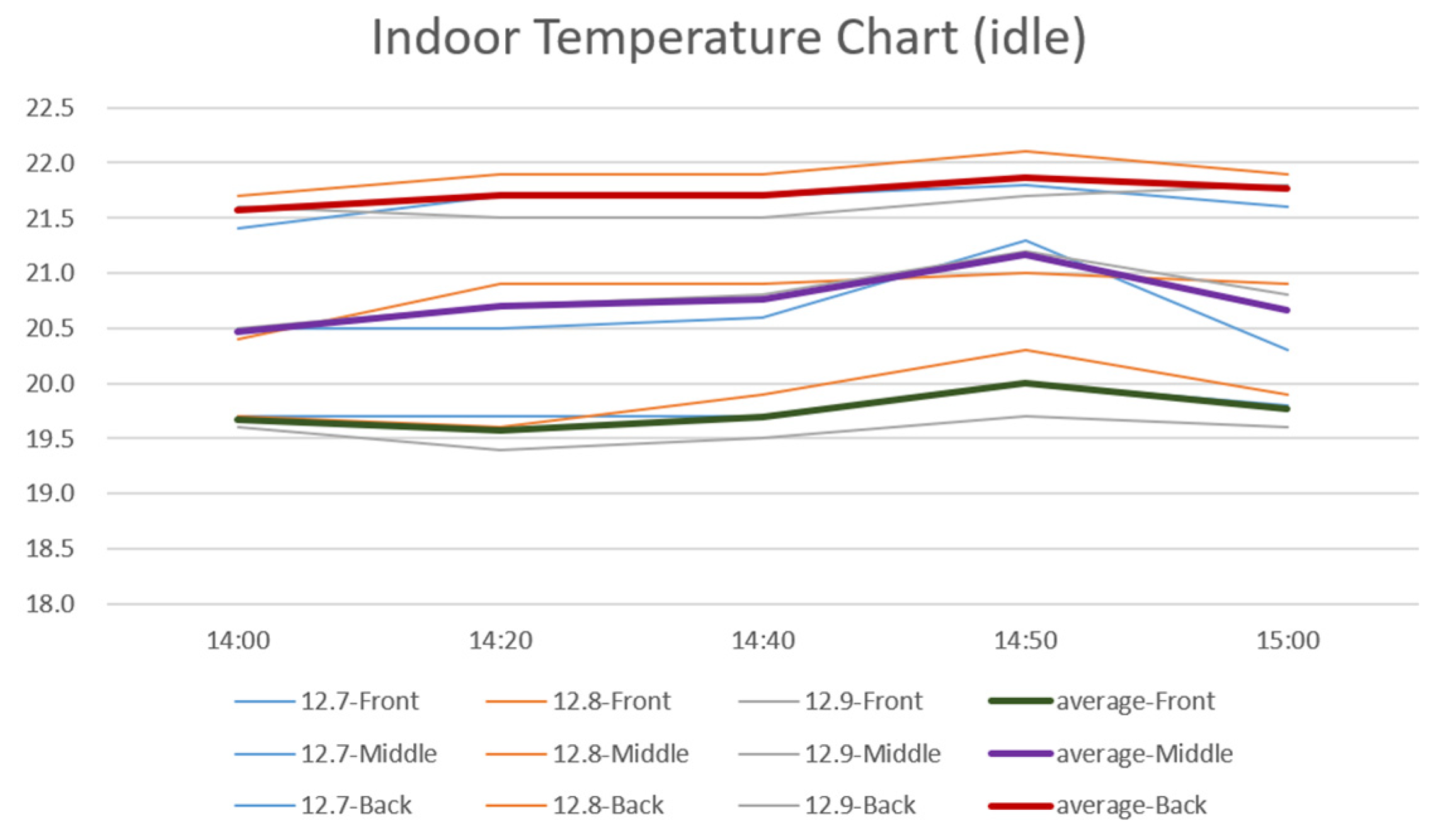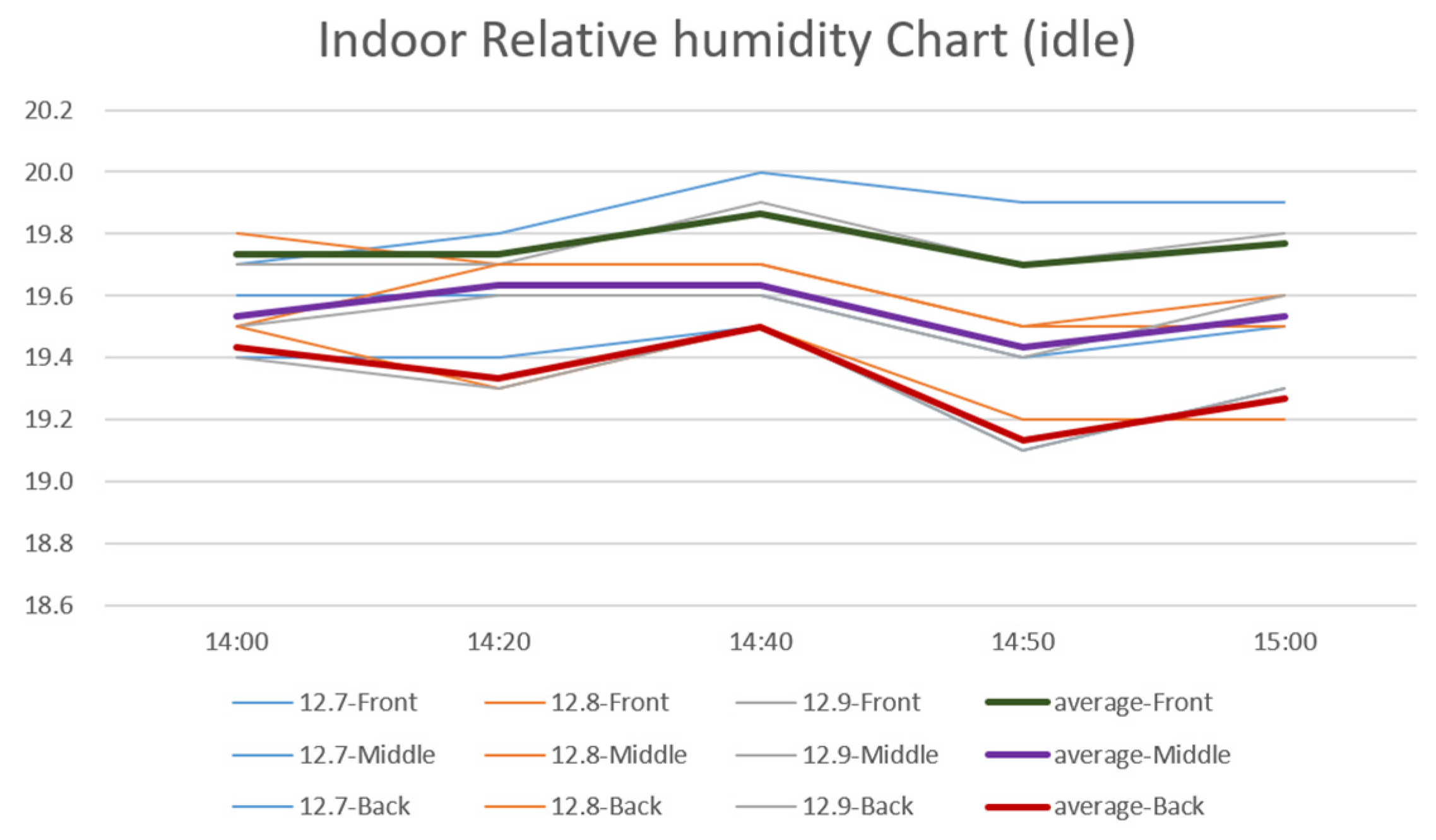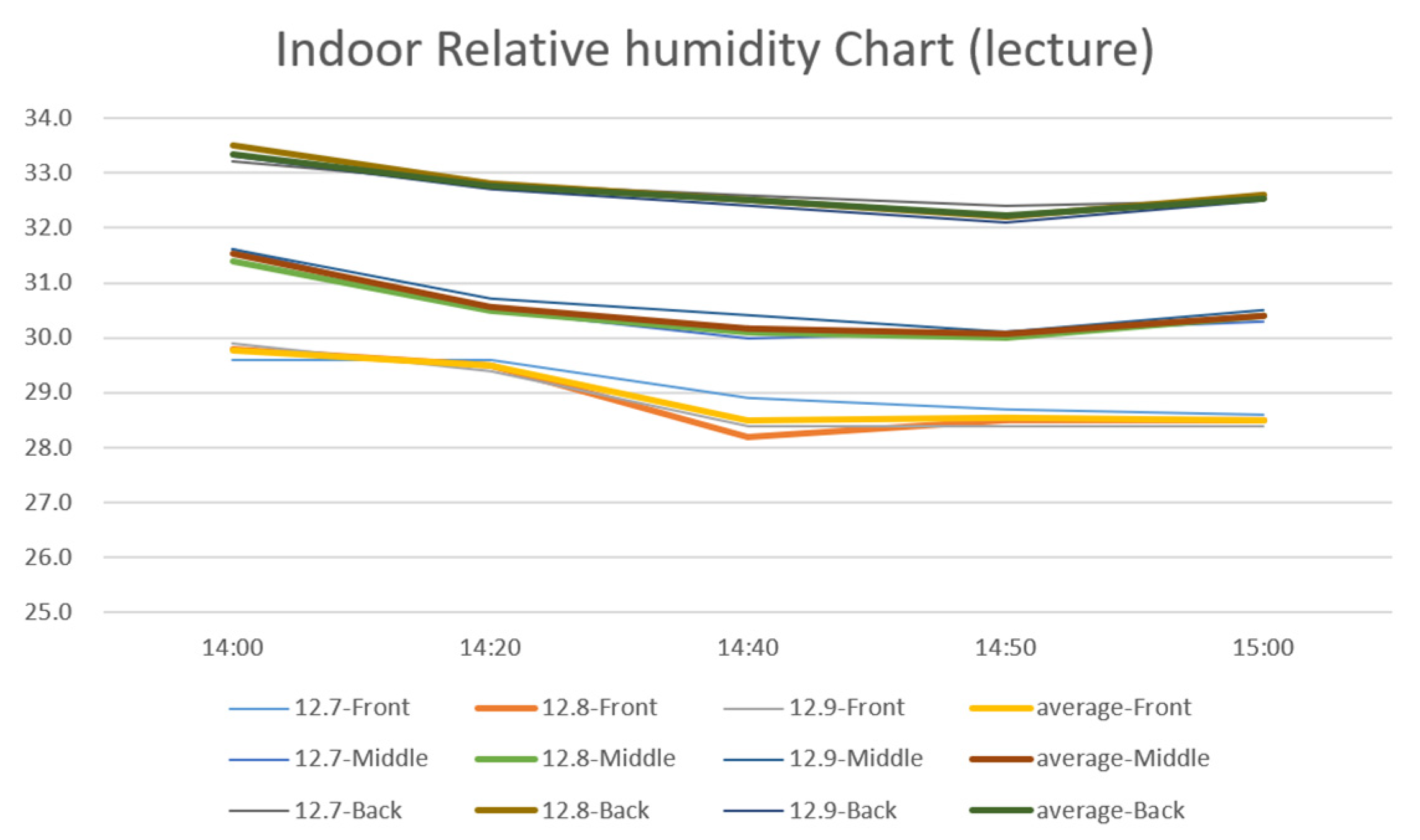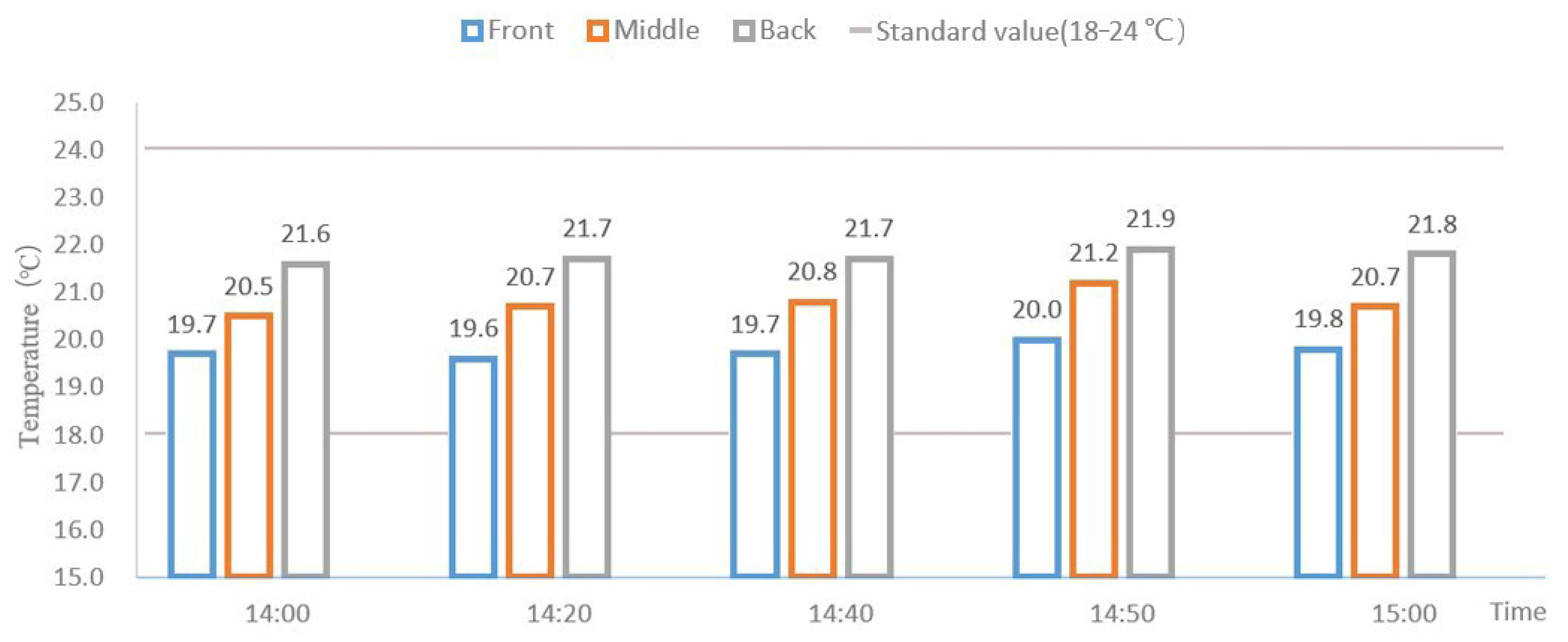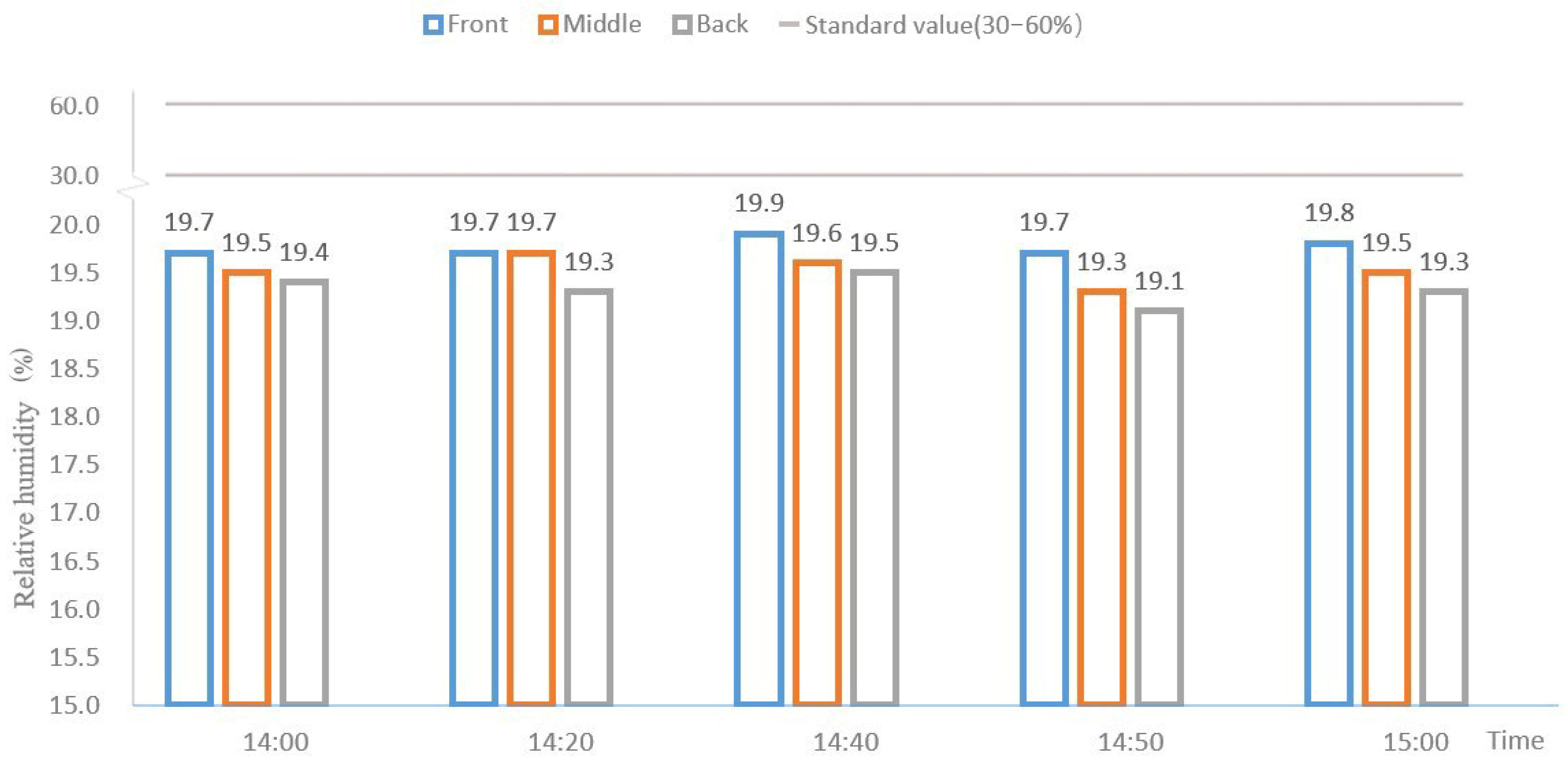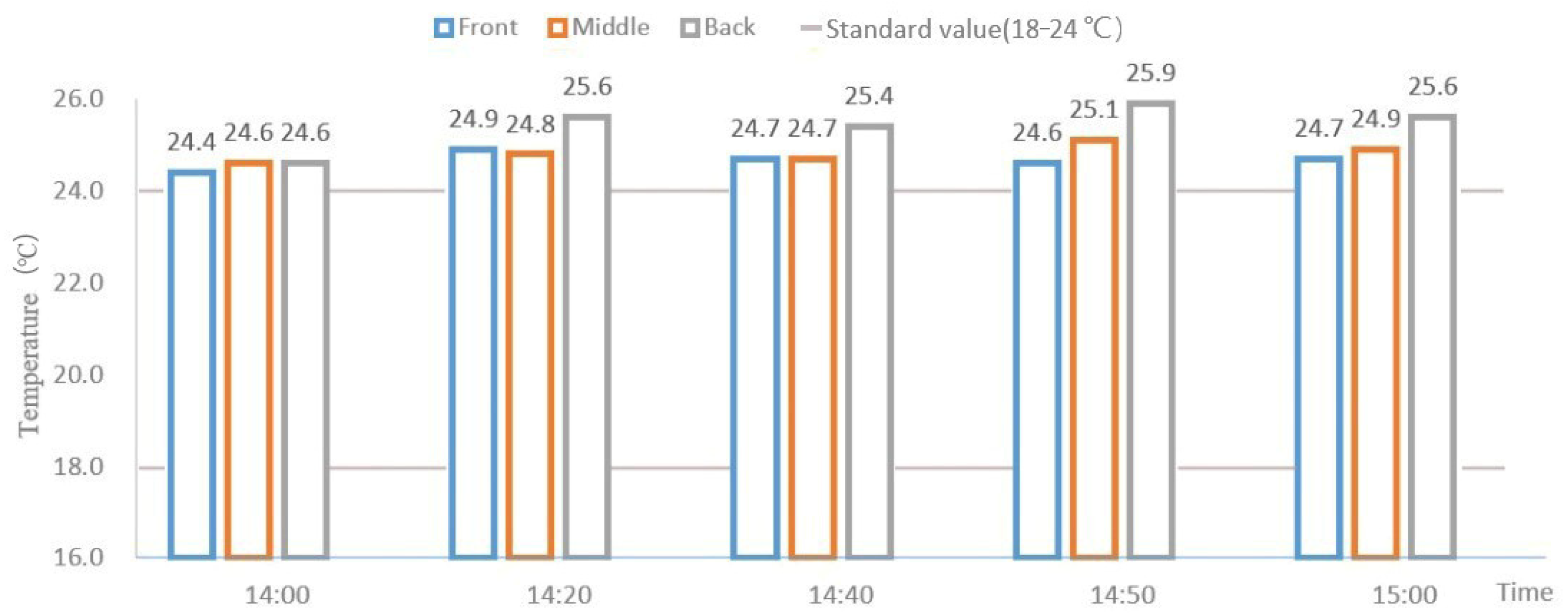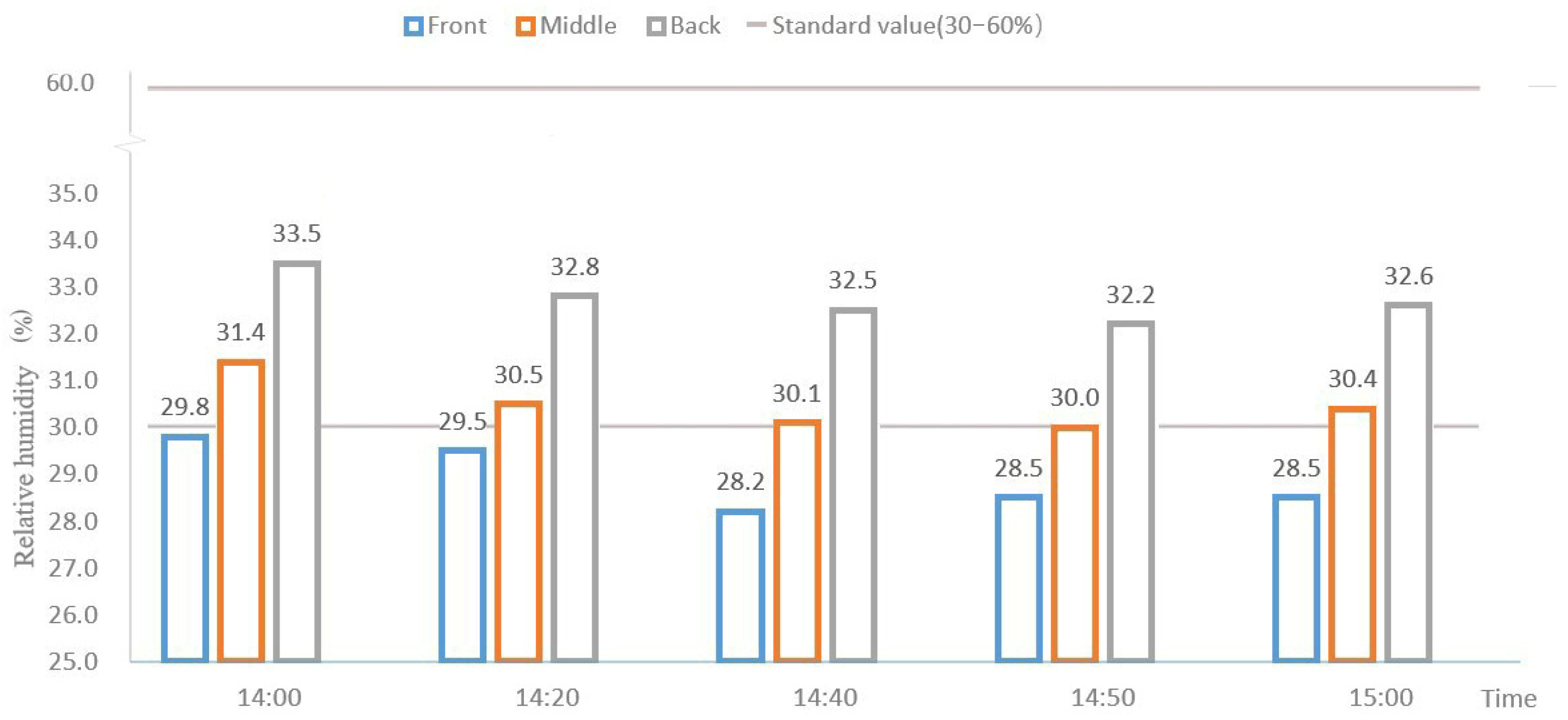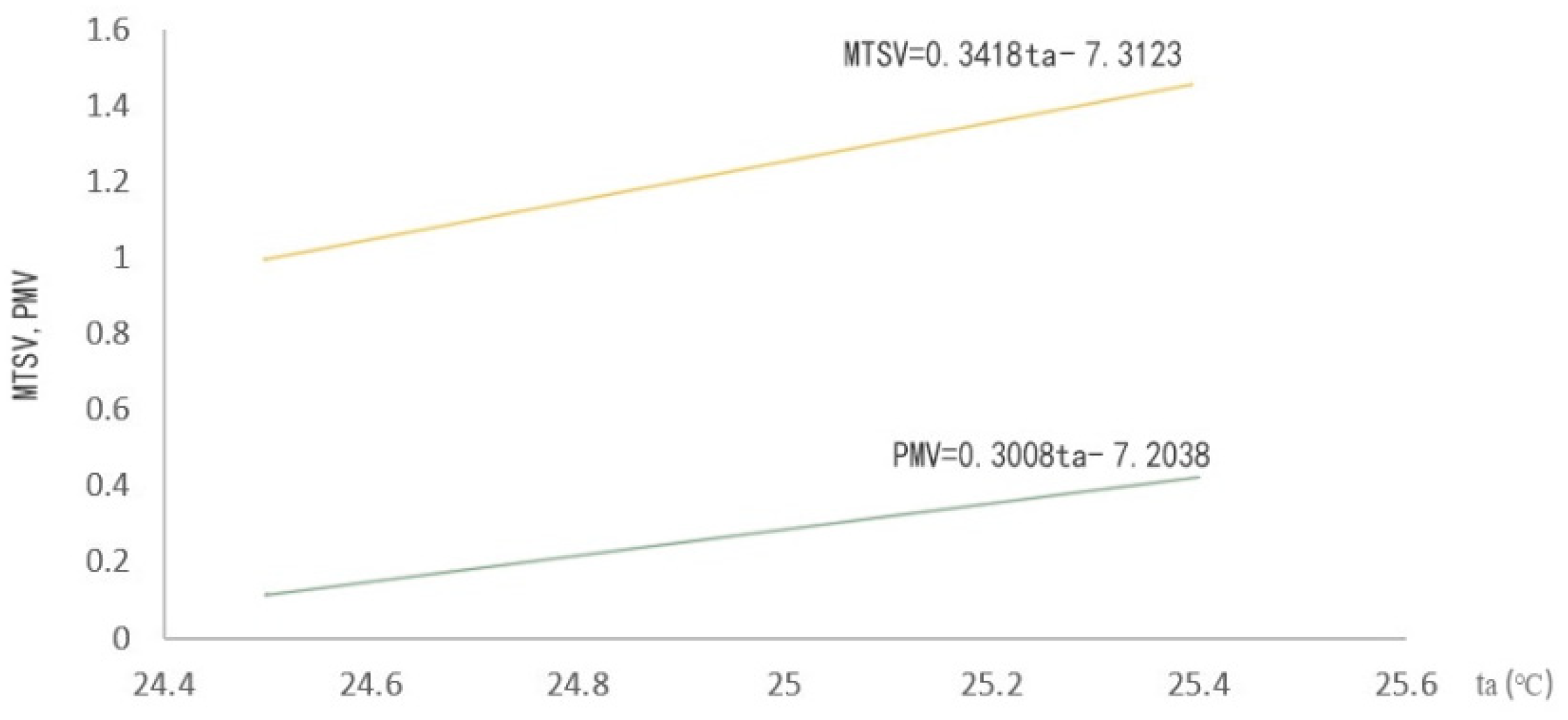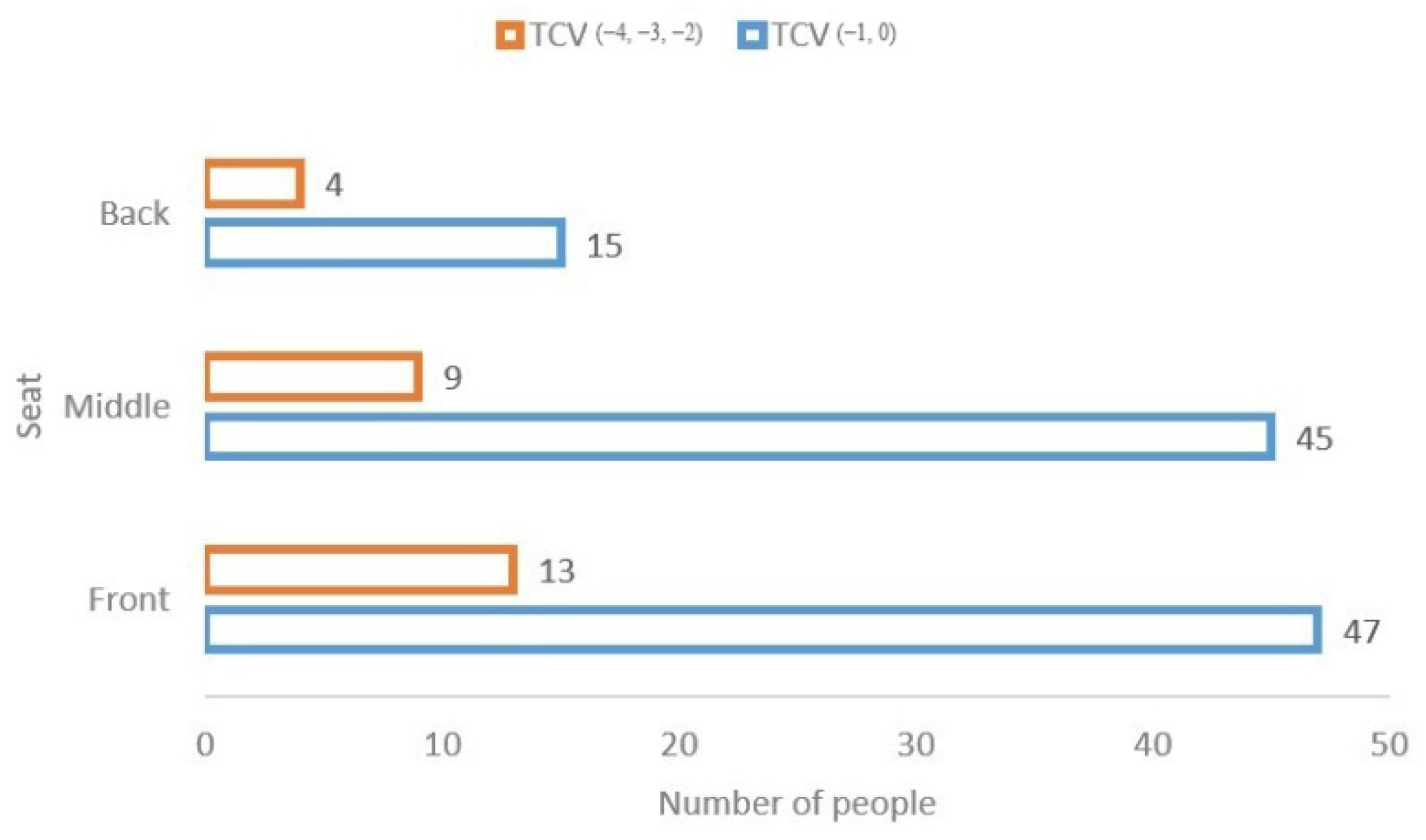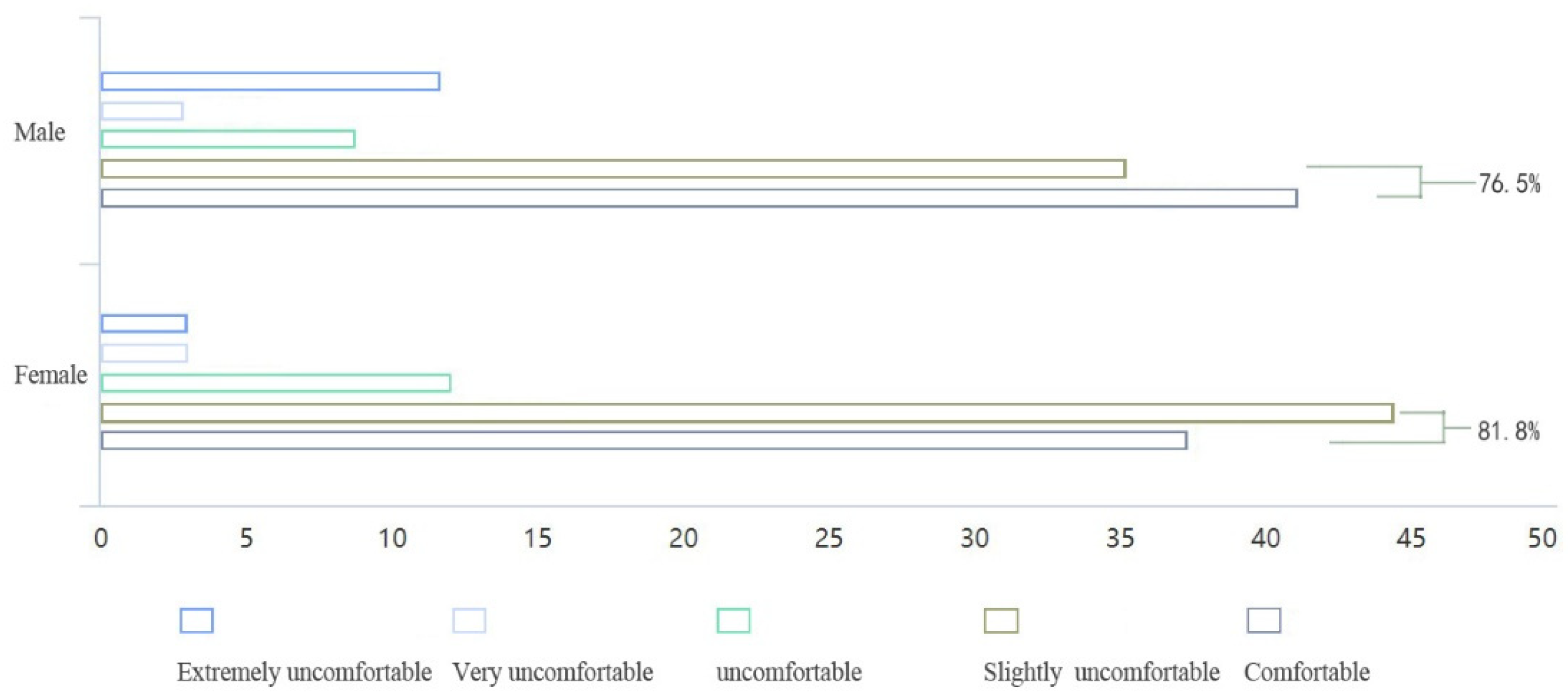Human thermal sensation is influenced by indoor air temperature, average radiant temperature, air flow rate, air humidity, thermal resistance of clothing, and the different metabolic rates of the subjects. During the test period, the classroom doors and windows were tightly closed, and the threshold of the human perception of wind speed was 0.20 m/s (GB/T 28591-2012) [
39]. The measured wind speed (≤0.05 m/s) was much smaller than the threshold of human perception of wind speed (
Table 5) and also comply with national standards [
37]. Thus, the effect of indoor wind speed on the evaluation of the subject’s thermal sensation could be ignored. In addition, the average radiation temperature and the thermal resistance of clothing were basically at constant values in this test. Therefore, this analysis focused on indoor air temperature and indoor relative humidity. A subjective survey was conducted in the classroom on the classroom’s quality of temperature and humidity. Note that the sitting rate in the classroom was over 90%, and the per capita volume was nearly 3.5 m
3 per person. The results show that 85% of the classrooms had a sitting rate of over 50% during the class, which means that in most classroom situations, the classroom was not empty. Thus, the impact of the people population density in the classroom on the environment and the impact of indoor density on the environment are representative.
4.2. Comparison of Mean Thermal Sensation Vote (MTSV) and PMV
Some scholars [
14] have proposed a linear regression equation for the average indoor thermal sensory vote in winter in severe cold regions versus air temperature; this equation can be expressed as follows:
where V
MTSV is the average thermal sensation, and t
a (°C) is the room temperature.
The significance levels of regression of Equation (6) were calculated as 0.005 by the F-test. This value implies that the linear regression equation is appropriate.
Note that this regression equation does not take into account the effect of human heat dissipation on the room temperature when the people population density is high. Accordingly, this equation is further modified in the present paper.
It should be noted that the following relationships were obtained by linear regression using the Bin method (temperature frequency method) for a regression analysis of the indoor air temperature. Note that the indoor temperature, relative humidity, and personnel density did not change much during the three days of 7–9 December, which include the same day that was chosen for the subjective questionnaire, i.e., 7 December. In addition, these parameters only include the data obtained from the 1 h field test measurements. The reason for choosing only this time period is to enable an accurate correspondence between the subjective and objective investigations.
The MTSV of the subjects was calculated as follows:
where V′
MTSV is the average thermal sensation, and ta (°C) is the room temperature.
The significance levels of regression of Equation (7) were calculated as 0.008 by the F-test. This value implies that the linear regression equation is appropriate.
If VMTSV and V’MTSV are zero, the thermal neutral temperature is calculated as 22.6 °C with Equation (6) and 21.4 °C with Equation (7). It can be seen that when the people population density is high, the thermal neutral temperature is relatively low. Note that when the initial operating heating temperature is set for large classrooms, further consideration should be given to the impact of personnel heat dissipation on the overall thermal environment of the space, in addition to meeting code requirements.
According to ISO standard 7726 [
38], in most practical cases where the relative velocity is small (<0.2 m/s) or where the difference between mean radiant and air temperature is small (<4 °C), the operative temperature can be calculated with sufficient approximation as the mean value of air and the mean radiant temperature. Furthermore, the corresponding predicted thermal sensory vote (PMV) values can be calculated by putting the corresponding parameters into the Chinese standard (GB/T 50785-2012) [
7]
Using the temperature frequency method, regression curves were obtained between the PMV values and room temperature as follows:
where PMV is the predicted thermal sensory vote value, and t
a (°C) is the room temperature.
The significance levels of regression of Equation (8) were calculated as 0.015 by the F-test. This value implies that the linear regression equation is appropriate.
Although the trends of the linear regression curves for the V′
MTSV model and the PMV model were generally consistent (
Figure 20), the slope of the V′
MTSV curve was larger than the PMV curve, indicating that the actual thermal sensation of the subjects was hotter than the predicted thermal sensation for the same room temperature. This implies that 49.6% of the subjects perceived the classroom to be hotter despite the thermally neutral PMV value at this operating condition.
The predicted thermoneutral temperature in Equation (8) was 23.9 °C, which is 2.5 °C higher than the thermoneutral temperature in Equation (7). This implies that the subjects had adapted to the colder outdoor climate at this stage and showed some rejection of the higher indoor heating temperature. It has been suggested in Ref. [
40] that prolonged high temperatures can weaken students’ ability to adapt to cold climates, and that the use of thermally neutral temperatures to set indoor heating temperatures can result in significant energy savings and improved thermal comfort.
4.3. Study of Coupled Temperature and Humidity Evaluation Models
The entropy weighting method mentioned in
Section 2.2.3 is used to normalize the temperature and relative humidity to obtain the standard matrix, which can be expressed as follows:
According to Equation (3), the information entropy of temperature and relative humidity is Hj = {0.32,0.51}.
According to Equations (4) and (5), the weight values of temperature and relative humidity are 0.58 and 0.42, respectively.
The predicted thermally neutral temperature of 23.9 °C can be calculated with Equation (8). Additionally, the corresponding relative humidity is 28% when PMV is zero. Note that according to the weighting value, the final evaluation score is 25.6 when PMV is zero, while according to the temperature and relative humidity of the front, middle, and rear areas, the evaluation scores are 26.6, 27.2, and 28.5, respectively. This implies that the thermal environment in the front area is the most suitable.
Figure 21 shows that the subjects in the front area had the highest thermal comfort, which is consistent with the final evaluation results of the entropy weighting method. This implies that the entropy weighting method can be used in the subjective analysis of thermal satisfaction.
4.4. Temperature Expectation, Relative Humidity Expectation, and Thermal Comfort
There are six main factors that affect human thermal comfort: human energy metabolic rate, clothing thermal resistance, air temperature, air humidity, airflow velocity, and average radiation temperature. The human energy metabolic rate, clothing thermal resistance, and average radiation temperature varied slightly in this experiment. Thus, our analysis focused on the TCV voting values (from −4 to −2). The results of a precise statistics calculation is plotted in
Table 7; it can be seen that 50% of the subjects felt that the room temperature could be lowered and that the relative humidity could be raised in subsequent improvement measures. However, higher relative humidity is not more beneficial, and some studies have shown [
41] that relative humidity should not exceed 60% in order to avoid thermal discomfort, which is also in accordance with the relevant national upper limit [
32]. Nevertheless, three of the subjects also chose not to change both environmental parameters, which may have been due to psychological reasons as teaching in the indoor environment is not autonomously controllable. Thus, the subjects might have had different degrees of additional thermal sensations, which would have affected the overall thermal comfort, although it is not related to the objective environmental parameters. It is also worth mentioning that some scholars have proved this point [
42].
4.5. Gender and Thermal Comfort
Both temperature and relative humidity are influencing factors of thermal comfort. However, the environmental factor that had a greater impact on thermal comfort was mainly air temperature due to the relatively low sensitivity of humans to humidity, which fluctuates within a range of ±15% [
43]. Furthermore, the relative humidity in the classroom during this test was generally low and relatively stable.
Information about the students’ sex is summarized in
Table 8. As can be seen in
Figure 22, in terms of gender influence, 81.8% of females and 76.5% of males voted for thermal comfort concentrated between −1 and zero. The average temperature in the classroom in the previous field test was 24.9 °C, indicating that at room temperatures above the prescribed value of 24 °C [
39], thermal comfort values were higher for females than for males in the same thermal environmental conditions. It should be noted that some studies on the same severe cold climate zone used a linear relationship between AMV (actual mean vote) and room temperature for different gender groups [
44]. These studies calculated the thermal neutral temperature of male and female subjects as 21.6 and 22 °C, respectively. Through the field measurements, the present study also proves that women prefer a warmer environment.
4.7. Limitations
First, the test time set in the experiment was in the afternoon. Thus, the present study did not cover indoor thermal environment conditions in the morning and evening. Second, the present study focused on a certain type of young people and did not cover the whole age group. In the future, it would be possible to further study the personnel density thresholds corresponding to the appropriate temperature and relative humidity in the classroom. Additionally, the test site chosen was north-facing in order to avoid the effects of sunlight exposure, which is relatively simple. The air quality in the classroom, which would have affected the overall comfort level in the classroom, was also not studied. Finally, in the context of the 2019 coronavirus pandemic, the impact of wearing masks on thermal comfort and the indoor environment should be considered. However, there was no epidemic in the Shenyang campus during the test time of this project, and the students were not wearing masks. Therefore, further research can be carried out to address these limitations.

